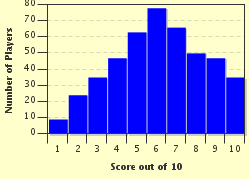Quiz Answer Key and Fun Facts
1. Here's a picture of a bone and all you need to do is identify it. I'll give you this much of a clue. It's the only bone in the body with no significant connections to other bones.
2. This is an illustration of the human ribcage. There are twelve ribs on each side, but how many of your ribs are attached to the vertebrae of your vertebral column or backbone?
3. The femur is the longest bone in the body, but approximately what percentage of a person's height is made up of the femur?
4. Ow! You've hit your 'funny' bone and it's not that funny. Pain is now travelling down your arm and for a few minutes, you have significant pain and possibly some numbness in your forearm and fingers. Are these symptoms due to the injury the bones in your arm have suffered?
5. If you ask a person to bend forward as in this picture, you can see and feel their vertebrae. Your vertebrae make up your spinal column, but which portion of each vertebra is prominently seen in this photo?
6. Your skull is made up of many bones. At birth, these bones aren't rigidly joined together but later fuse into a solid, protective casing for your brain. In the picture here, you can see the irregular lines where the bones have joined. What are these joins called?
7. When you break a bone, it undergoes a process of healing that can take many months until normal bone tissue is restored and the bone has its original strength. This photo shows a tibia which had been healing until the patient passed away of other causes. You can see the lump of material caused by the healing process is rather wider than the bone itself at this stage. What is this collection of tissue called?
8. The stapes is the tiniest bone in the body, positively minuscule compared to the femur. In common with many other medical terms, its medical name comes from Latin. What does the Latin 'stapes' mean? You might get a hint from the picture.
9. Here's a picture of the base of the skull, as seen looking down into the empty skull. The area highlighted in green (at the bottom of the picture) surrounds a large hole through which your spinal cord leaves your skull and descends to the body. What is the name of this great hole?
10. Along with the bones in your body are often found arteries, veins and nerves named after that bone. For instance, the femoral artery is found in association with the femur. When feeling for a pulse in a person's wrist, which pulse can be felt just a centimetre or two from the base of the thumb?
Source: Author
Tizzabelle
This quiz was reviewed by FunTrivia editor
CellarDoor before going online.
Any errors found in FunTrivia content are routinely corrected through our feedback system.

